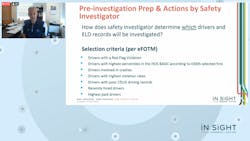A commercial motor carrier’s failure to ensure that a driver’s hours of service (HOS) records are accurate remains a top violation—even in the world of electronic logging devices (ELDs). And Department of Transportation audits show that the ELD mandate hasn’t stopped some truckers from trying to falsify their records.
Dave Osiecki, president and CEO of Scopelitis Transportation Consulting and a 34-year transportation industry veteran, noted during the virtual Trimble in.sight user conference on Aug. 26 that when undergoing compliance investigations, it is important for trucking companies to know what to prepare for and what to look out for. Safety investigators refer to the Electronic Field Operations Training Manual (eFOTM), essentially the playbook for the Federal Motor Carrier Safety Administration (FMCSA) and its state partners to conduct audits.
There are two elements by which the government audits ELD records for HOS compliance: A pre-investigation component and the actual investigation of records. During the pre-investigation stage, an investigator verifies that ELDs are indeed required to be used by the company. They also verify that the company’s devices meet the requirements under the federal mandate.
Investigators also confirm with the company that the ELD data can be retrieved electronically and can be transmitted to the investigator either on-site or off-site through an electronic portal between the company and FMCSA. Additionally, the ELD requirement determines which driver records will be audited.
“It’s important to know if you’re going to be undergoing an audit which drivers they are going to select and how many drivers they will select,” Osiecki advised. “Investigators also provide the company with a list of the drivers’ ELD data being requested. Then, they provide the company with a link for uploading that data.”
Investigators then retrieve the data, look at the data and request supporting documents, such as bills of lading or other types of pay records or scheduling records, that the company might have.
Osiecki pointed out that drivers with the highest percentiles in the Compliance, Safety, Accountability Behavior Analysis and Safety Improvement Category (CSA BASIC) will be selected for audits. Essentially, investigators pinpoint drivers involved in reportable crashes, drivers with the highest violation ratings for roadside inspections, and recently hired drivers, for instance.
During the investigation, investigators will conduct a basic review of the ELD records and a review for the falsification of those records. Part of that process involves investigators interviewing key personnel within the business to understand the operations. They will try to understand each step—from the booking of the freight with the customer and the paperwork that transpires between the customer and the driver and then back to the company. Investigators also interview other people, including drivers, to understand how the process works from the driver’s perspective and to see how the driver’s story correlates with operations’ story.
Investigators will also request various back-office reports from the ELD system. They ask for the unassigned driving miles report and the edited reports made by the driver or someone else who is officially logged in. They also ask for odometer jump reports to see if a report shows the truck was moved and the odometer jumped without actual driving time, Osiecki pointed out.
Investigators also look for violation reports. “There is no requirement in the ELD rule for the system to generate a violation report, but most ELD providers have software that does it. That is designed for the company to help identify which drivers may be violating, but it’s also something that government investigators are aware of, and they ask if it’s there,” Osiecki said.
Safety investigators will review each change of duty status and check it with ELD data. Specifically, they look for violations of the 11-hour, 14-hour, 60/70 weekly hour rules, and 30-minute rest break requirement, Osiecki noted. Investigators will also check for unassigned driving miles, meaning miles in which the truck is moved but there is not a person logged into the ELD. They will also check for system malfunctions and data diagnostics noted in the ELD data to determine if there’s an impact on HOS compliance.
Digging deeper for falsification
Although ELDs were designed to provide a more accurate depiction of HOS records, falsification of driver records can still happen, Osiecki pointed out. To figure out whether records have been fabricated, investigators will review the list of log-in and log-out activity. They will also look at the unassigned driving time to see if one driver is using another driver’s login to get more hours.
Investigators will also look at locations and try to verify that the on-duty location of the driver matches the same location where the driver went off-duty to determine whether the vehicle was moved when the driver was in off-duty status. Currently, the 30-minute rest break must be in an off-duty status, so investigators will seek to verify that all those rest breaks are in non-driving periods and that they begin and end in the same location.
“When we do mock audits of a company, we find that some drivers do try to take rest breaks while they are fueling the truck, yet they are showing they’re in an off-duty status,” Osiecki explained.
He also pointed out that the federal government believes personal conveyance is the most common source of false log violations. Because of that, investigators will scrutinize whether the driver using the personal conveyance status used it properly and consistently with the FMCSA guidance.
Investigators also will verify notes, edits and any comments that the driver made in the adaptions and will review description reports to see where all this activity took place. Falsification may occur when the driver edits on-duty, non-driving time to off-duty or sleeper-berth time, Osiecki said.
Investigators will review the ELD settings to determine if there are features that allow the company to customize any threshold. For instance, under the federal mandate, the ELD has to reflect driving time as soon as that truck hits 5 mph of driving or more. Investigators will look for whether there is a feature in the override settings to increase that 5 mph setting.
Before an audit or compliance investigation, Osiecki advised that trucking companies make sure their ELD records are organized, accessible and that more than one person in the office knows how to access those records. He also suggested fleets create and follow an internal auditing system to ensure their drivers are following the rules.
“Consider getting some ‘outside eyes’ on ELD records to conduct a mock audit and investigation consistent with ELD procedures,” Osiecki suggested. “It can be helpful to get an outside set of eyes on selecting drivers and asking for their records. See if you can access and transmit them, and then have somebody take a look at them.”
Ultimately, he advised that trucking companies have a solid grasp of the government’s auditing practices and procedures before compliance investigations occur.





